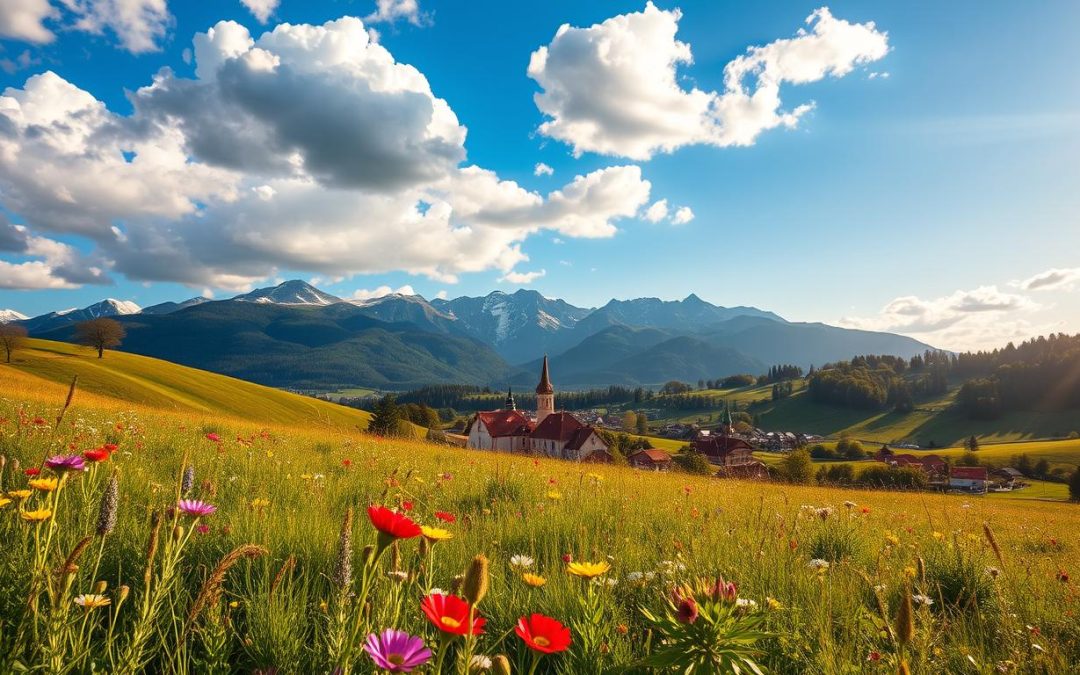Ever wondered how to plan a trip that perfectly balances great weather and unforgettable experiences? Poland offers a unique blend of climates and attractions that cater to every traveler’s preferences. From coastal breezes to mountain adventures, this destination has it all.
Whether you’re exploring the historic streets of Warsaw or the charming alleys of Krakow, each city has its own seasonal charm. The coastal regions provide refreshing summer escapes, while the inland areas are perfect for cultural festivals. Mountain lovers can enjoy crisp air and stunning views any time of the year.
Planning your visit around the weather ensures you make the most of your day. This guide will help you choose the ideal time to explore Poland’s rich history, vibrant festivals, and natural beauty. Let’s dive into what makes this country a must-visit destination!
Key Takeaways
- Poland features diverse climates, from coastal to mountain regions.
- Summer is ideal for festivals and outdoor activities in cities like Warsaw and Krakow.
- Coastal areas offer cooler temperatures, perfect for summer escapes.
- Mountain regions provide year-round opportunities for adventure.
- Plan your trip around cultural events and weather for an unforgettable experience.
Discover Poland’s Diverse Climate
From sunny coasts to snowy peaks, Poland’s weather offers something for everyone. This place is a fascinating mix of climates, shaped by its geography. Whether you’re strolling through the historic streets of Warsaw or exploring the charm of Krakow, each region has its own unique weather patterns.
Coastal cities like Gdansk enjoy milder temperatures, thanks to the Baltic Sea. In summer, the breeze keeps things refreshing, making it perfect for beach outings. Inland areas, however, experience more extreme temperatures. Warsaw, for example, can get quite warm in July, with average highs around 64°F (18°C).
Mountain regions like Zakopane offer cooler conditions year-round. Winter brings snow-covered landscapes, ideal for skiing, while summer provides crisp air and stunning views. These geographical contrasts make Poland a versatile destination for all seasons.
Understanding these differences can greatly enhance your travel experience. Coastal areas are perfect for those who enjoy milder weather, while inland cities offer vibrant cultural scenes. Mountain lovers will find endless opportunities for adventure.
Poland’s diverse climate patterns add to its charm. Whether you’re planning a trip around festivals or outdoor activities, knowing the weather variations ensures you’ll make the most of your visit. So, pack accordingly and get ready to explore this weather-rich destination!
Understanding Poland’s Seasonal Weather Patterns
Understanding the seasonal shifts in this region can make your trip more enjoyable and well-prepared. Each area offers unique weather experiences, shaped by its geography. Whether you’re planning a coastal retreat or a mountain adventure, knowing what to expect ensures a smoother journey.
Regional Climate Variations: Coastal, Inland, and Mountain Areas
Coastal areas, like Gdansk, enjoy milder nights and warm days, thanks to the Baltic Sea. Summers are refreshing, with average highs around 64°F (18°C). Inland cities, such as Warsaw, experience more extreme temperatures, often reaching 77°F (25°C) in July.
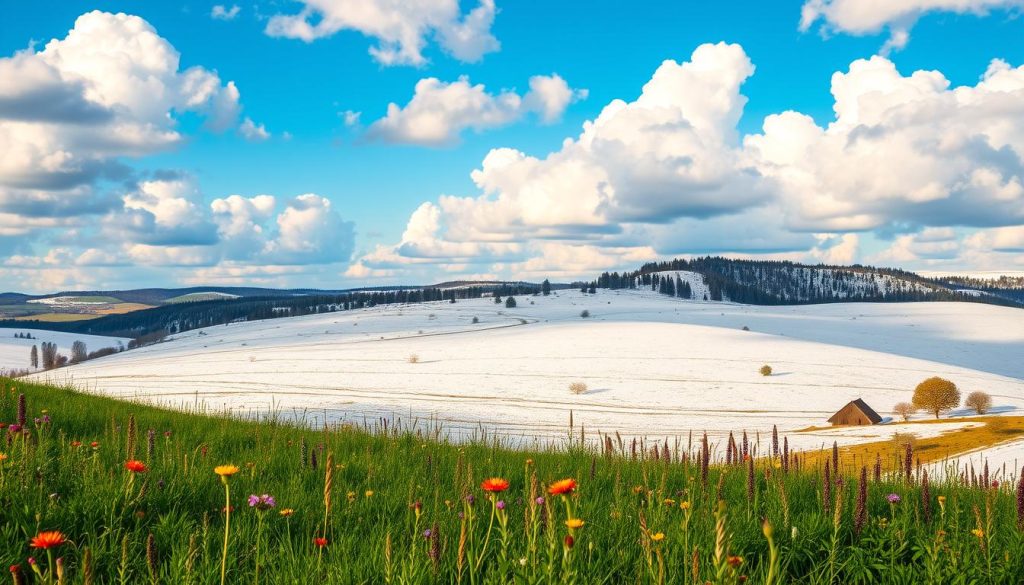
Mountain regions, like Zakopane, offer cooler conditions year-round. Winter brings snow-covered landscapes, perfect for skiing, while summer provides crisp air and stunning views. These contrasts make the country a versatile destination for all seasons.
Average Temperatures and Rainfall Insights
Average temperatures vary significantly by region and time of year. In spring, temperatures range from 46°F to 64°F (8°C to 18°C), making it ideal for outdoor activities. Summer sees highs of 77°F (25°C), especially in inland areas.
Rainfall is moderate throughout the year, with higher precipitation in summer due to thunderstorms. Winter brings frequent snowfall, particularly in January and February. Understanding these patterns helps you plan your activities and pack accordingly.
Being prepared for weather shifts is crucial. Coastal areas are perfect for those who enjoy milder weather, while inland cities offer vibrant cultural scenes. Mountain lovers will find endless opportunities for adventure.
Poland: Best Months for a Weather-Savvy Trip
Timing your visit can make all the difference in experiencing Poland’s vibrant culture without the stress of crowds. Planning around festivals and peak travel times ensures a smoother, more enjoyable trip. Whether you’re drawn to lively events or prefer quieter moments, understanding the rhythm of the country’s calendar is key.
Navigating Crowds and Festival Peaks
Peak travel months like August and May often coincide with major festivals, such as Wianki and Juwenalia. These events draw large crowds, making streets and hotels busier than usual. To avoid overwhelming situations, consider visiting during shoulder periods when festivals are fewer but the weather is still pleasant.
Checking local event calendars is a smart way to plan your trip. This helps you balance popular events with a relaxed travel experience. For example, Wianki, a midsummer celebration, is a must-see but can be crowded. Arriving a few days early or staying longer can help you enjoy the festivities without feeling rushed.
Even during peak times, festivals add a unique cultural flavor to your visit. They offer a chance to immerse yourself in local traditions and connect with the community. With informed planning, you can make the most of these experiences while keeping your trip enjoyable.
| Month | Festival | Crowd Level |
|---|---|---|
| May | Juwenalia | High |
| August | Wianki | Very High |
| June | None | Moderate |
Balancing weather and event schedules is essential for a memorable trip. By choosing the right time to travel, you can enjoy Poland’s rich culture and stunning landscapes without the hassle of crowds. Start planning today to create an unforgettable adventure!
Spring in Poland: Renewal and Relaxed Sightseeing
Spring in this region brings a sense of renewal, making it the perfect time for relaxed sightseeing. As the snow melts and nature awakens, you’ll find blooming landscapes and rejuvenated cities. This season offers a unique blend of mild weather and fewer crowds, creating an ideal setting for exploration.
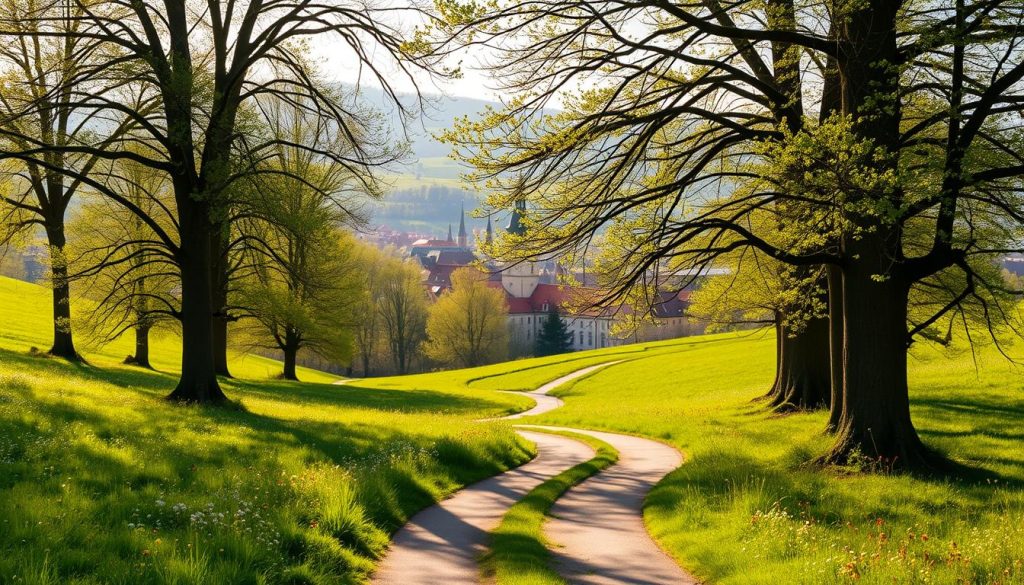
March to May: What to Expect in Early Blooms
March starts with a chilly breeze, but by April, the countryside is alive with vibrant colors. May brings comfortable warmth, perfect for outdoor activities. The progression from cool mornings to sunny afternoons makes this season a joy for travelers.
Spring is ideal for cultural excursions and outdoor cafes. With fewer tourists, you can enjoy a calm and authentic experience. Historic sites are less crowded, allowing you to explore at your own pace. Cities like Krakow and Warsaw are especially inviting during this time.
Packing layers is essential due to shifting temperatures. A light jacket for mornings and evenings will keep you comfortable. Don’t forget comfortable shoes for leisurely walks through charming streets and parks.
Here’s a quick guide to spring weather and activities:
| Month | Average Temperature | Recommended Activity |
|---|---|---|
| March | 46°F (8°C) | Visit historic sites |
| April | 55°F (13°C) | Explore blooming gardens |
| May | 64°F (18°C) | Enjoy outdoor cafes |
Spring is a wonderful time to visit Poland and experience its natural beauty and cultural richness. Whether you’re strolling through historic streets or enjoying the fresh air, this season promises a memorable adventure.
Summer in Poland: Festivals, Fun, and Warm Weather
Summer in this country is a vibrant mix of festivals, warm weather, and endless adventures. From bustling cities to serene mountain retreats, there’s something for everyone. The lively atmosphere and pleasant temperatures make it the perfect time to explore.
Hot Days, Cool Evenings, and Packing Tips
During summer, temperatures in lowland areas can reach up to 80°F (27°C), while mountain regions like Zakopane offer cooler evenings. This variation means you’ll need to pack smart. Light clothing is essential for daytime, but don’t forget layers for cooler nights.
Here are some packing essentials for your summer trip:
- Lightweight, breathable clothing for hot days.
- A light jacket or sweater for cooler evenings.
- Waterproof footwear for unexpected rain showers.
- Sunscreen and a hat to protect against the sun.
Summer is also the season for outdoor festivals and cultural events. From June to August, cities like Sopot come alive with music, art, and athletic competitions. The Sopot Grand Prix, held in June, is a highlight for sports enthusiasts.
If you’re heading to the mountains, enjoy crisp air and stunning views. Zakopane is a popular destination for hiking and relaxation. Coastal areas like Sopot offer refreshing sea breezes and long, sunny days perfect for beach outings.
Here’s a quick look at average summer temperatures across different regions:
| Region | Average High (°F) | Average Low (°F) |
|---|---|---|
| Lowlands | 80 | 60 |
| Mountains | 70 | 50 |
| Coastal | 75 | 55 |
Evenings are perfect for outdoor dining, with temperatures cooling down just enough to enjoy a meal under the stars. Plan ahead to navigate summer crowds, especially during major festivals. Arriving early or staying longer can help you make the most of your visit.
Summer in this area is all about embracing the warmth and energy of the season. Whether you’re exploring urban attractions or natural wonders, you’re in for an unforgettable experience.
Fall in Poland: Cozy Atmosphere and Breathtaking Foliage
Fall transforms the landscape into a canvas of warm hues, inviting you to explore its serene beauty. As the leaves turn golden, a peaceful atmosphere settles over the region, perfect for a relaxing getaway. This season offers a unique blend of stunning scenery, cultural charm, and fewer crowds, making it an ideal time to visit.
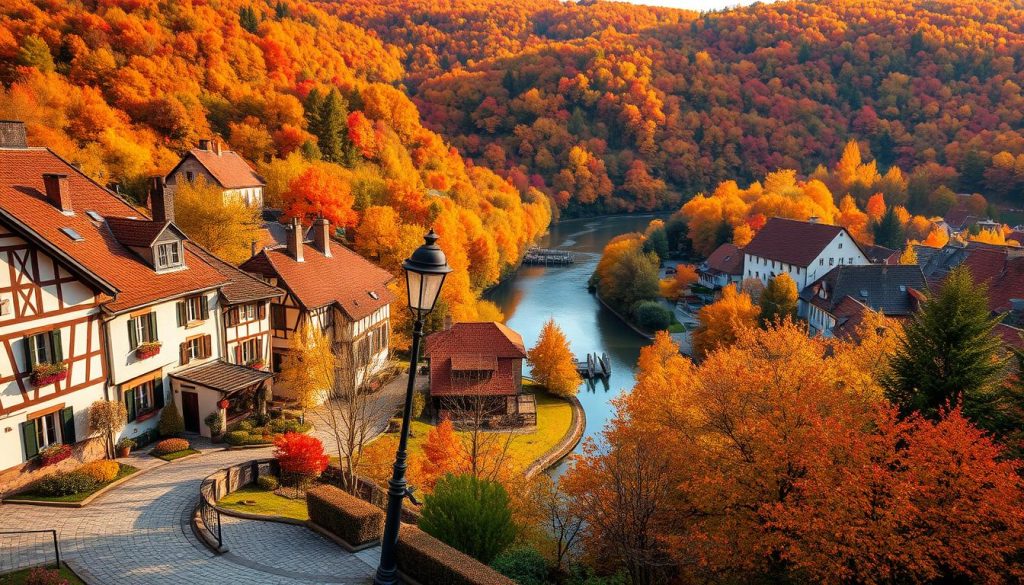
Embracing Seasonal Transitions and Hotel Deals
Autumn brings cooler temperatures, creating a cozy atmosphere that’s perfect for outdoor adventures. Cities like Krakow and Wroclaw shine during harvest time, with seasonal markets and cultural events adding to their charm. The crisp air is ideal for hiking in areas like Zakopane, where you can enjoy breathtaking views without the summer crowds.
One of the biggest perks of traveling in fall is the cost savings. Many hotels offer reduced rates during this off-peak season, making it easier to enjoy a comfortable stay without breaking the bank. Whether you’re exploring urban parks or natural reserves, the vibrant foliage provides a picturesque backdrop for your adventures.
Here’s what you can expect during a fall visit:
- Vibrant autumn colors in urban parks and countryside landscapes.
- Peaceful, less crowded environments for a relaxed experience.
- Discounted accommodations and fewer tourists at popular sites.
- Seasonal markets and harvest festivals showcasing local traditions.
- Perfect weather for outdoor activities like hiking and cycling.
Fall is also a great time to enjoy the coastal areas, where the beach towns offer a quieter retreat. The cooler temperatures make it pleasant to stroll along the shore or explore nearby attractions. Whether you’re seeking adventure or relaxation, this season has something for everyone.
Plan your trip to embrace the magic of fall. With its stunning landscapes, cozy atmosphere, and budget-friendly options, it’s the perfect time to create unforgettable memories. Pack your layers and get ready to experience the beauty of this enchanting season!
Winter in Poland: Snowy Adventures and Cultural Charm
Winter transforms the region into a snowy wonderland, offering both adventure and charm. From thrilling sports to festive markets, this season brings a unique blend of excitement and tradition. Whether you’re exploring mountain resorts or strolling through historic towns, the cold weather adds a magical touch to your experience.
Top Winter Sports and Magical Christmas Markets
Mountain resorts like Zakopane are a haven for winter sports enthusiasts. Skiing, snowboarding, and snowshoeing are just a few activities you can enjoy. The crisp air and stunning views make it a perfect destination for adventure seekers. For a more relaxed experience, take a scenic cruise along frozen rivers or lakes, offering breathtaking views of the snowy landscape.
Urban areas come alive with festive cheer during the holiday season. Cities like Krakow and Warsaw host enchanting Christmas markets, where you can find handmade crafts, traditional treats, and warm drinks. Wroclaw’s market is one of the largest in Europe, attracting visitors with its dazzling lights and lively atmosphere.
“The magic of winter lies in its ability to bring people together, whether on the slopes or at the market square.”
Here’s a quick guide to winter activities and temperatures:
| Activity | Location | Average Temperature (°F) |
|---|---|---|
| Skiing | Zakopane | 28 |
| Christmas Market | Wroclaw | 34 |
| Winter Cruise | Vistula River | 30 |
To stay warm during your winter adventures, pack essential clothing like thermal layers, waterproof boots, and insulated jackets. Don’t forget accessories like gloves, scarves, and hats to protect against the cold.
Embrace the season and create unforgettable memories. Whether you’re hitting the slopes or sipping mulled wine at a market, winter here is a truly enchanting experience.
Regional Highlights: Top Cities and Destinations
Exploring Poland’s cities reveals a blend of history, culture, and culinary delights that captivate every traveler. From the bustling streets of Warsaw to the charming alleys of Krakow, each town offers unique experiences. Whether you’re drawn to architectural marvels or vibrant food scenes, these destinations promise unforgettable adventures.
Warsaw, Krakow, Wroclaw and More
Warsaw, the capital, is a hub of modernity and history. Visit the Old Town, a UNESCO World Heritage site, and explore the Royal Castle. For a taste of local food, head to Zapiecek, a popular restaurant known for its pierogi. The city’s average temperature in summer hovers around 77°F (25°C), making it ideal for outdoor exploration.
Krakow, with its medieval charm, is home to the Wawel Castle and the historic Main Market Square. Don’t miss the Cloth Hall, where you can shop for traditional crafts. For a culinary treat, try the street food at Plac Nowy, famous for its zapiekanka. Krakow’s mild spring temperatures, around 64°F (18°C), make it perfect for sightseeing.
Wroclaw, known as the “Venice of Poland,” boasts stunning architecture and picturesque canals. The Market Hall is a must-visit for fresh produce and local delicacies. Enjoy a meal at Pod Fredrą, a renowned restaurant offering Polish classics. With an average temperature of 59°F (15°C) in October, fall is a great time to explore this vibrant town.
Here’s a quick overview of average temperatures in these cities:
| City | Season | Average Temperature (°F) |
|---|---|---|
| Warsaw | Summer | 77 |
| Krakow | Spring | 64 |
| Wroclaw | Fall | 59 |
Beyond the major cities, lesser-known destinations like Gdansk and Poznan offer hidden gems. Gdansk’s maritime history and Poznan’s colorful Old Town are worth exploring. Each region adds its own flavor to your journey, making Poland a diverse and captivating destination.
Whether you’re strolling through historic streets or savoring local dishes, Poland’s cities invite you to immerse yourself in their unique culture. Start planning your trip today and discover the charm of these urban treasures!
Unforgettable Festivals and Cultural Events
Poland’s festivals and cultural events are a vibrant celebration of music, art, and history, offering something for every traveler. From lively summer jazz festivals to enchanting winter markets, these events provide a unique glimpse into the country’s rich traditions. Timing your visit to coincide with these celebrations can make your trip even more memorable.
Local Music, Art, and Historical Celebrations
Poland’s festival calendar is packed with events that cater to diverse interests. The Krakow Summer Jazz Festival, held in July, is a must for music lovers. It features performances by world-renowned artists in stunning outdoor venues. For those who enjoy art, the Wianki festival in June transforms the city into a magical space with floating lanterns and live performances.
Winter brings its own charm with events like the Christmas markets in Wroclaw and Krakow. These markets are filled with handmade crafts, traditional treats, and festive decorations. They’re a perfect way to experience the warmth of Polish hospitality during the colder months.
Historical commemorations, such as the Warsaw Uprising anniversary in August, offer a deeper understanding of the country’s past. These events often include reenactments, exhibitions, and public gatherings, making them both educational and engaging.
Here’s a quick guide to some of the most popular festivals:
- Krakow Summer Jazz Festival: July, featuring outdoor concerts.
- Wianki: June, with lanterns and live performances.
- Wroclaw Christmas Market: December, offering crafts and treats.
- Warsaw Uprising Anniversary: August, with historical reenactments.
Many of these events take place in urban parks and public spaces, creating a lively atmosphere. Whether you’re enjoying a jazz concert under the stars or browsing a Christmas market, these festivals add a special touch to your visit.
To make the most of your trip, consider planning your visit around these events. Arriving a few days early or staying longer can help you enjoy the festivities without feeling rushed. With so much to see and do, Poland’s festivals promise a vibrant cultural journey that you’ll never forget.
Practical Travel Tips for Your Visit to Poland
Planning a trip to this destination requires a mix of preparation and flexibility to enjoy every moment. Whether you’re exploring historic streets or cruising along a scenic river, being well-prepared ensures a smooth and memorable experience. Here’s how to make the most of your journey.
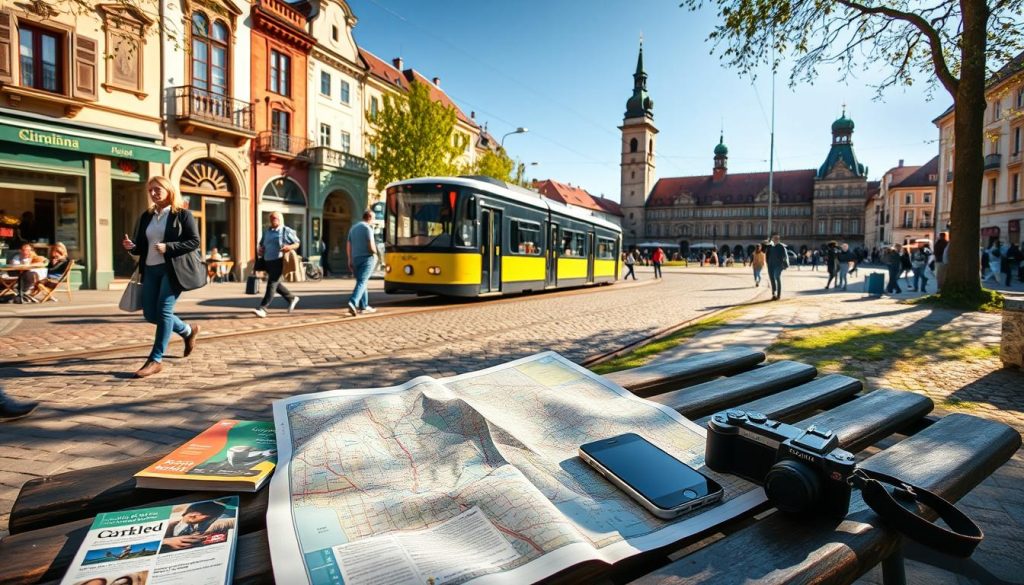
Must-Have Essentials for a Weather-Savvy Trip
Packing smart is crucial for handling fluctuating weather. In march, layers are your best friend. Bring a mix of lightweight clothing for warmer days and a warm jacket for cooler evenings. Don’t forget waterproof footwear and an umbrella for unexpected rain showers.
Here’s a quick checklist for your trip:
- Lightweight, breathable clothing for warm days.
- A warm jacket or sweater for cooler evenings.
- Waterproof shoes and an umbrella.
- Sunscreen and a hat for sun protection.
Exploring by foot is one of the best ways to experience the charm of this region. Walking through historic streets allows you to discover hidden gems and local culture. For a unique perspective, consider a river cruise, which offers stunning views and a relaxing way to travel.
Here’s a comparison of transportation options:
| Option | Benefits |
|---|---|
| Walking | Discover hidden gems and local culture. |
| River Cruise | Stunning views and a relaxing experience. |
| Public Transit | Affordable and efficient for longer distances. |
Safety is another important consideration. Always stay aware of your surroundings, especially in busy areas. Keep your belongings secure and avoid displaying valuables openly. Familiarize yourself with local emergency numbers and have a map or GPS handy for navigation.
Don’t miss out on the local culinary scene. Street food and traditional restaurants offer a taste of the region’s culture. Try local specialties like pierogi or zapiekanka for an authentic experience. Planning your meals around popular spots can save time and enhance your trip.
With these tips, you’ll be ready to handle any weather and enjoy every moment of your visit. Pack smart, stay safe, and embrace the adventure!
How to Prepare for Poland’s Changing Weather
Preparing for unpredictable weather can make or break your travel experience. Whether you’re visiting in april or september, the climate can shift dramatically from day to night. Being ready for these changes ensures you stay comfortable and enjoy every part of your trip.
Layering Techniques and Adaptable Clothing Strategies
Layering is your best friend when dealing with fluctuating weather. Start with a lightweight base layer, add a warm middle layer, and finish with a waterproof outer layer. This approach lets you adjust easily as temperatures change throughout the day.
Here are some tips for selecting versatile wardrobe pieces:
- Choose breathable fabrics like cotton or merino wool for comfort.
- Opt for neutral colors that can mix and match easily.
- Pack a lightweight jacket for cooler evenings.
Waterproof gear is essential, especially during summer showers. A compact travel umbrella can save the day when unexpected rain hits. These items ensure you’re prepared whether you’re exploring cities or hiking in nature.
Ergonomic packing techniques can also make a big difference. Roll your clothes to save space and use packing cubes to stay organized. Planning ahead helps you avoid weather-related disruptions and keeps your journey smooth.
By mastering these strategies, you’ll be ready to handle any weather conditions. Stay comfortable, stay prepared, and make the most of your adventure!
Discover Local Cuisine and Traditions
Polish cuisine is a gateway to understanding the country’s rich heritage and traditions. From hearty pierogi to sweet paczki, every dish tells a story of resilience and creativity. Exploring these flavors is more than a meal—it’s a journey into the heart of culture.
Traditional dishes like bigos, a savory stew, and pierogi, stuffed dumplings, are staples that reflect centuries of history. Street vendors offer treats like giant pretzels, while quaint restaurants serve authentic meals in cozy settings. Each bite connects you to the region’s past and present.
Food markets are a must-visit for travelers. Here, you’ll find fresh produce, handmade goods, and a vibrant atmosphere. In october, harvest festivals bring these markets to life, showcasing seasonal specialties and local traditions. It’s a perfect time to immerse yourself in the culinary scene.
Pair your meals with local beverages for a complete experience. Polish beer, known for its rich flavor, complements hearty dishes like zrazy or potato pancakes. For dessert, try lody, a creamy ice cream that’s a favorite among locals.
Modern interpretations of traditional dishes add a fresh twist to the culinary landscape. Chefs are reinventing classics with lighter ingredients, appealing to both locals and visitors. Whether you’re dining at a resort or a street-side café, the flavors are unforgettable.
Exploring the culinary traditions of this region is more than just eating—it’s about connecting with the culture. From festive markets to family-run restaurants, every meal is an opportunity to celebrate the heritage and warmth of the people. So, dive in and savor the experience!
Conclusion
Exploring a destination with diverse seasons offers endless opportunities for unique experiences. From vibrant summer festivals to cozy winter markets, each time of year brings its own charm. Understanding the weather patterns and planning accordingly can make your journey even more enjoyable.
Spring and fall are perfect for those who prefer milder temperatures and fewer crowds. Summer is ideal for outdoor adventures and lively events, while winter transforms the landscape into a snowy wonderland. No matter when you visit, there’s always something special to discover.
By aligning your trip with seasonal highlights, you can create unforgettable memories. Whether it’s hiking in crisp mountain air or strolling through colorful autumn foliage, the possibilities are endless. Start planning your adventure today and embrace the magic of every season.
Thank you for exploring this guide. We hope it inspires you to embark on a journey filled with rich experiences and lasting memories. Check out more detailed resources to make your travel dreams a reality!
The above is subject to change.
Check back often to TRAVEL.COM for the latest travel tips and deals.
Here are some Tours & Sightseeing suggestions that might pique your interests!
